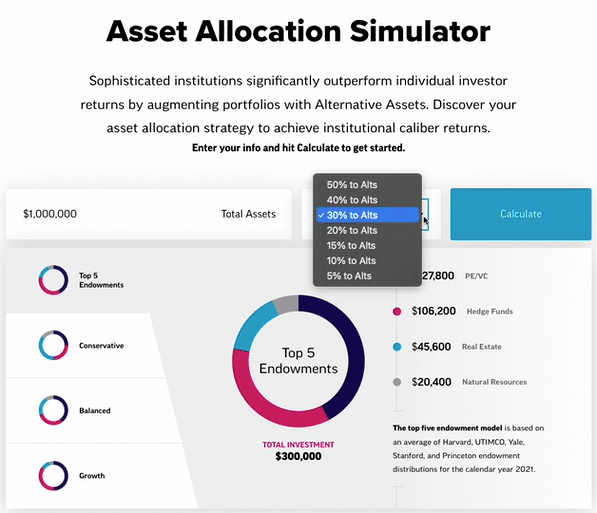It’s a well-documented fact that individuals are increasingly investing in private markets, and this is likely to accelerate when considering the future performance of a public stock portfolio.
The fear is that individual investors will invest more heavily in SPVs run by managers with no skin in the game (not deploying any of their own money into the deal). SPVs can bundle together any type of investment opportunity, including those that may be high risk or have little oversight and governance. This can lead to investors taking on more risk than they may be aware of or comfortable with.
Investing alongside managers who have experienced multiple economic cycles and have the discipline to follow a sound long-term strategy is key to capturing returns in today’s environment. These managers that have discipline on price, ownership, and selection, enable investors to build portfolios of private market companies with strong advisory teams who understand their businesses, have a perspective on the broader market outlook, and the experience to weather volatility.
-Logan Henderson, Founder and CEO

A “dip” in the market may actually be a great time to invest in the next generation of tech companies. Read more.

During an economic downturn, private equity investors can take solace in the fact that their investments have historically outperformed public equities. Read more.
A reporter asked us this week about how Tiger Global’s use of consultants helped them to deploy capital rapidly, and what the implications are of the market changes.
While the strategy allowed them to allocate capital to high-growth companies (a key evaluation criteria for Gridline is preferential access to investments), initial portfolio construction is only half the job of a manager.
What happens with the portfolio after you have selected it is the other half, and that work includes key elements such as board work, recruiting teams, and working to get exits / maximize value.
The easy-money streak over the last 4 years led to poorly thought-out expansion strategies and high cash burn, and many of these companies will struggle to transition to an environment where each raised dollar needs to be considered their last.
Tiger Global’s 2021 fund has already completed 360 deals, and while there are certainly some highly capable management teams, many of these companies will require the thoughtful advice of experienced managers.
That is a significant portfolio to be actively engaged with, and only time will tell overall performance.
Let us know what you think – please don’t hesitate to reach out.
-The Team at Gridline
The year has started with heightened volatility given changing monetary policy, inflationary pressures, and geopolitical risk, but there are positive signs in the market. However, strong jobs and wage growth, healthy corporate balance sheets, and a reset in private valuations should present compelling investment opportunities.
Investors that are deploying capital now are entering the investment at a compressed valuation (lowering the cost basis) which may provide the same or better returns with lower hurdles (commonly referred to as “the goalposts”). A 3x return on a $500m investment looks very different from a 3x return on a +$1bn investment.
Retail investors may be even more likely to turn to the private markets as they consider the current performance of their public stock portfolio. Two common approaches that may present more risk than investors are aware of:
Many investors may invest more heavily in SPVs run by managers with no skin in the game (not deploying any of their own money into the deal).
SPVs can bundle together any type of investment opportunity, including those that may be high risk or have little oversight and governance. This can lead to investors taking on more risk than they may be aware of or comfortable with.
A commonplace you see individual investors look for private market exposure is by investing in secondary common stock (ie, purchasing an employee’s exercised options) which are many times sold based on the last preferred equity round.
There is a big difference between the underlying value of preferred stock and common stock, and with companies raising capital at lower or flat valuations, the holder of the common stock will have a much larger preferred overhand given they get priority on proceeds (and often times will have a ratchet in late-stage funding rounds).
Investing alongside managers who have experienced multiple economic cycles and have the discipline to follow a sound long-term strategy is key to retail investors capturing returns in today’s private market environment.
These managers that have discipline on price, ownership, and selection, enable retail investors to build portfolios of private market companies with strong advisory teams who understand their businesses, have a perspective on the broader market outlook, and the experience and perspective to weather volatility.
I recently re-read an article from Clayton Christensen, an esteemed writer, professor at Harvard Business School, and one of the most influential business thinkers in the world. A key point the author makes is that when we use a product, we essentially “hire” it to help us do a job.
In that context, what is Gridline’s job to be done?
Our job is to provide access to the highest quality private market investment opportunities with the potential to deliver outsized returns to our members. The universe of private market investment options dwarfs those in public markets, and there is considerable variance in performance between top and bottom managers in private, alternative asset classes. We have evaluated hundreds of opportunities, and less than 5% of the funds were reviewed to meet our standards. We do that hard work, so you don’t have to.
We’re excited to launch some exciting new products, and if you’d like to chat about our selection process and what’s to come, please reach out.
-Logan Henderson, Founder and CEO

The key to successful alternative investing is to find high-quality assets that fit your investment goals and objectives. Read more.

Read more as we dive into this topic on last week’s blog.
You’ve probably seen Fidelity’s bitcoin / 401(k) announcement. A couple of big takeaways here…
We know next-gen wealth don’t invest like their parents – no matter what the SEC or Warren Buffett says – and Fidelity is one of the first large institutions to enable retirement savings allocations to bitcoin and other digital assets in the future.
Our view: bitcoin is the gold standard, with a market cap larger than Meta and AT&T combined, but instead of focusing on bitcoin exclusively, investors should allocate a portion of their portfolio to both a basket of cryptocurrencies and to the companies building and innovating on the underlying technologies behind crypto and web3 more broadly.
Investments in PE funds in this space would place bets on the future of the crypto industry while addressing the SEC’s concerns on crypto, given that funds operate within a regulatory framework defined by the SEC.
Let us know what you think – please don’t hesitate to reach out.
-The Team at Gridline
The year has started with heightened volatility, given changing monetary policy, inflationary pressures, and geopolitical risk, but there are positive signs in the market. Solid jobs and wage growth, healthy corporate balance sheets, and a reset in private valuations should present compelling investment opportunities.
Investing alongside managers who have experienced multiple economic cycles and have the discipline to follow a sound long-term strategy is key to capturing returns in today’s environment.
We’re excited to be rolling out products across private equity and credit this quarter and will continue to provide access to compelling managers committed to delivering strong investment performance to our users.
-Logan Henderson, Founder and CEO

Discover your asset allocation strategy to achieve institutional-caliber returns with our portfolio simulator.

Read more as we navigate a volatile market with alternative investments in our blog.
Logan Henderson contributed to CNBC on how next-get investors are pivoting from their parents’ investing strategies. TL;DR:
Let us know what you think – please don’t hesitate to reach out.
-The Team at Gridline
A quick reminder of why we’re here. Private market investing has operated on a flawed model. When it comes to the product side, the process of identifying, accessing, evaluating, and deploying capital into the best products has left much to be desired. Much of this process involves navigating through outdated, analog systems that do not provide investors with the transparency necessary to make informed decisions and select the most suitable investments. Whether individuals are managing their investments independently or relying on wealth managers, it’s doubtful that they are maximizing their investment potential. By enhancing, or rather replacing, the current processes, we are confident that we can significantly improve the returns for our customers compared to the current status quo.
On the transaction side, which includes tasks like developing allocation plans, completing subscriptions, and managing post-closure activities such as reporting, tax compliance, and portfolio modeling, the entire system is antiquated. It involves the sharing of PDF documents, the exchange of physical paperwork, unexpected capital calls, corralling K-1s, and overcoming non-standardized reporting frameworks. This outdated approach applies to endowments, family offices, wealth managers, and high-net-worth individuals alike.
When it comes to fees, the existing model has too many intermediaries involved, some disclosed and others hidden, leading to excessive frictional costs that erode investment returns. When digging deeper, it becomes evident that some of these fees result from the outdated and analog methods employed by established players in the industry. We are committed to passing on these efficiency gains to our customers, providing them with superior products and a vastly improved overall investment experience.
Our mission remains simple – to provide investors with access to top-performing investment products, all wrapped in a dramatically improved digital user experience with fair pricing.
-Logan Henderson, Founder and CEO
When you look around at the universe of investment opportunities, it becomes clear that private markets are broken.
The market for alternatives — things like venture capital, private equity, real estate and crypto — is booming, with more than $5 trillion expected to come into this market over the next four years. It’s further proof that the traditional 60/40 portfolio allocation model doesn’t work anymore with yields low and public equities hitting all-time highs. Generating the returns investors are used to requires taking on more risk, driving all this attention in alternative asset classes.
But there’s one problem.
While public markets are more accessible than ever — with social media and fee-free trades attracting a whole new generation of investors — private markets remain closed off, even to high net worth individuals. Supply and demand is concentrated among a select group of insiders.
We built Gridline to solve these persistent inefficiencies. We want to help individuals invest like the most successful endowments and family offices that are using alternative investments to generate excess returns. Big endowments like Yale put as much as 60% of their portfolio in alternatives and are reaping the benefits as a result of having exposure to diversified, non-correlated assets.
The problem isn’t just on the investor side. Emerging and even established fund managers are spending weeks and months — as much as a third of the time they’re raising capital — just identifying potential investors. Even the largest global funds struggle with how to bring retail investors into the fold and diversify the contribution base.
Those investors are out there, but they’re stuck on the sidelines waiting for an invite.
What alternatives have been clamoring for is a matchmaker, that connective tissue that brings investors who aren’t experiencing the returns they want and alternative asset managers who need a bigger audience together in a unified marketplace. Gridline achieves this by providing access to an expertly curated set of funds while leveraging technology to streamline the often cumbersome process of investing in alternatives.
We’re strong believers in the power of actively managed funds. The alternative investment landscape has seen a lot of focus on investments in individual companies or things like one-off real estate deals. But we’ve worked with great advisors and capital allocators and know the added value they can bring in turning a good company into a great business over time.
That’s why we’re starting with venture capital funds that we’ve picked based on a comprehensive selection criteria, with a bent toward managers with results verified by empirical evidence and a vested ownership in their funds’ success. These are not people spinning up an SPV to capture the upside with none of the downside risk — their livelihood depends on the success of the total fund and their investors get that benefit. Our users will be able to access these funds — which traditionally required as much as $1 million in liquidity — with minimums as low as $100,000. We’re keeping our fees low, charging an AUM fee that ranges from 0.5%-1.0% on invested capital.
The financial products themselves are only part of the problem we’re addressing. We’re also building industry-leading technology to improve the “rails” that make investing in these asset classes challenging. We’ve seen this kind of transformation in areas where offline, manual financial processes have been replaced by fintech applications in payments, lending and other banking services.
In alternatives, there’s a lot of messy back-end processes like investor questionnaires, KYC, treasury management, capital calls and tax reporting that can all be done digitally. We’re automating and leveraging technology to make that part as easy as executing a trade in the public markets online.
Tackling both sets of challenges I’ve described opens up private markets to a whole new set of investors. Investing in these asset classes today is out of reach for far too many and we’re excited to be building a future where everyone can have access to endowment-style investing and reap the superior returns it offers.
Put simply, we are building a platform that enables individual investors to emulate what the smartest investors in the world are doing with their portfolios. Our platform provides individuals the ability to discover and build a highly diversified alternative asset portfolio while concurrently expanding the pool of investors funds can leverage … we hope you join us on this journey.
Alternative investments have historically operated in an opaque marketplace. It’s hard to get access and it can be just as difficult to perform due diligence. Tack on excessive fees pervasive in private markets and it can be difficult to succeed as an investor in private markets.
Transparency is one of the central values we built Gridline on and it’s a key way we ensure our customers are as successful. We are a trusted advisor that provides access to sound investments. We’re doing this in two key ways: Our fund selection process and our simple fee structure.
Our fund manager selection process is rigorous, mixing elements of art and science to ensure our users are successful. We break this process down into our four Ps: Performance, People, Process and Philosophy. These four principles mix qualitative and quantitative measures to sort the managers who have true skill from those who may have just gotten lucky.
Once we make our selections, we are transparent in passing our findings onto users. Every opportunity within Gridline’s marketplace provides key pieces of information to give users a comprehensive view of risks each opportunity.
This includes a traditional “tear sheet” with key details on the fund’s team, investment thesis and past performance.
As a registered investment advisor ourselves, we act in your best interest. Part of that is providing the Gridline Perspective on each investment. This perspective is a synopsis of what went into making sure the evaluation process is robust and unbiased, why our experts think this is a sound investment and our take on what gives the fund’s team a unique edge.
Opening up the world of alternative investments to a wider swath of investors is exciting.
This is a space where a home run can mean huge returns. Individual investors now have the opportunity to allocate capital like the most sophisticated institutions. But often we see main street investors paired with the riskiest deals that have little oversight once their money is deployed.
Investing in alternative assets, like a venture capital fund, is a little more complex than just buying a stock or even a mutual fund. Picking winning companies is only half of what good fund managers do. They spend as much — or more — time nurturing these investments to ensure they’re successful.
That’s why picking actively managed funds — and, by extension, the fund manager — are so critical in this arena. Passive SPVs and rolling funds may provide access to interesting deals but they are by nature less engaged in ensuring the underlying investments are successful once the capital is deployed.
These kinds of investment vehicles can easily make money just on the management fees, but lose nothing when the underlying investments fail. You may want to pause a bit when you see these opportunities announced with rocket sign emojis. Fund managers should be key advisors to the companies they invest in, providing expertise and value to help everyone come out a winner.
The selection component of a manager’s job isn’t easy, either. Consider for a moment the difference in the options available between the more efficient public markets — where data on every company is readily available — and opaque private markets. Mutual funds may have to pick from a few thousand securities while the options available to venture capitalists is the universe of a half-million private companies.
Skill matters here and it’s easy to make a misstep. Manager dispersion bears this out, showing that the difference between top and bottom-quartile managers is more than 7.5 times greater in private markets. Top managers in private equity beat even the average manager by two times.
Managing a fund is difficult work that requires real skill. How do you avoid the duds and pick one that maximizes your return? Gridline takes this job seriously, performing extensive due diligence on every fund we invest in and offer to our users. We’ve broken down our process into four principles, the four Ps.
Everything we do at Gridline is focused on maximizing returns for our members. This includes our selection process, which ensures you have access to managers who can pick sound investments and actively manage those companies to produce returns that beat the public markets.